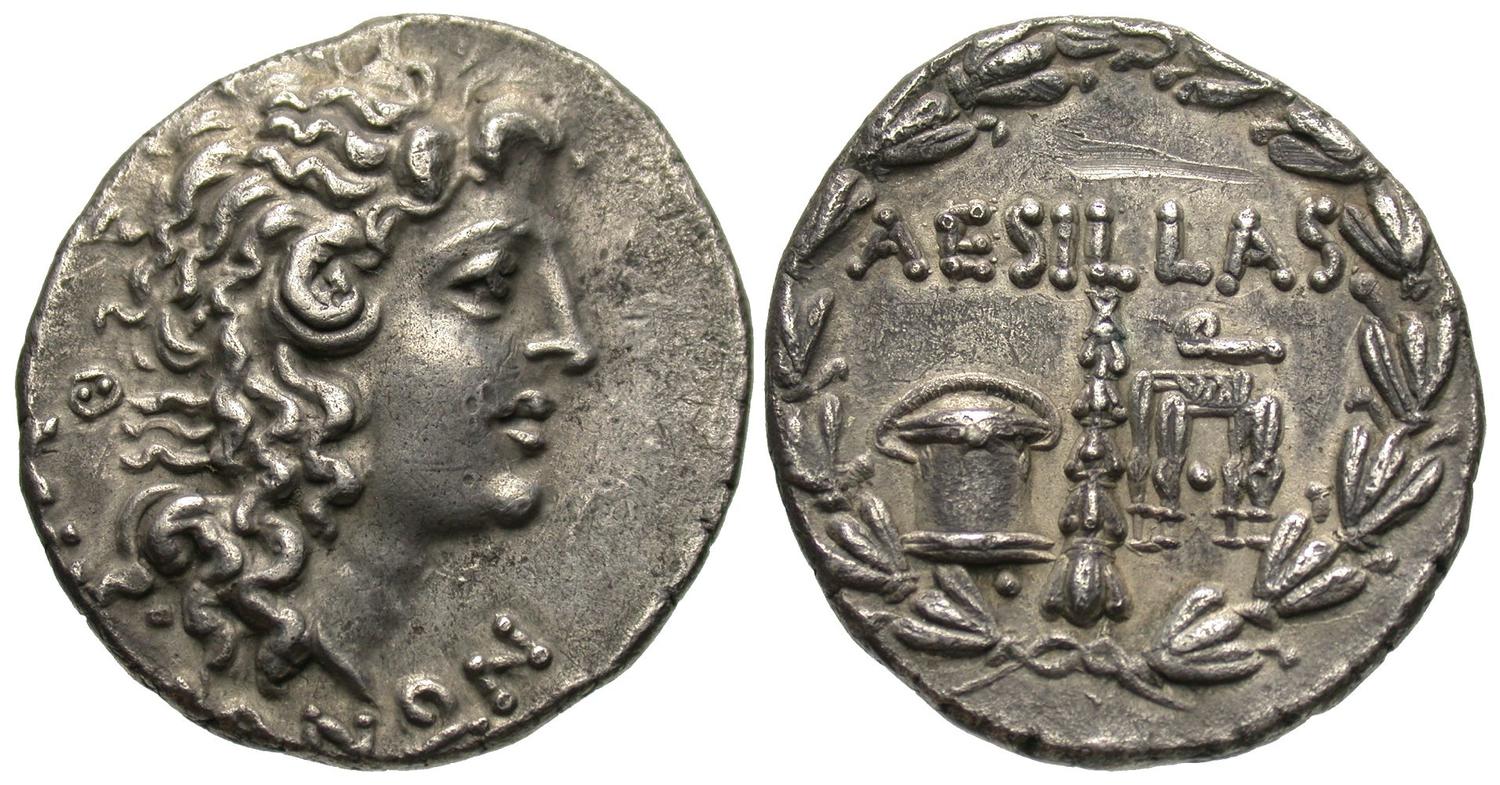Thessalonica? (Aesillas), silver, tetradrachms (100-65 BCE) Callataÿ
From SILVER
100 BCE - 65 BCE Silver 33,557 kg
Description
| ObverseInscription or printing placed on the obverse.: | MAKEΔΟΝΩΝ (Greek).Diademed head of Alexander the Great right. |
| ReverseInscription or printing placed on the reverse.: | AESILLAS (Latin).Money chest, club and chair, all within wreath. |
Mint and issuing power
| MintIdentifies the place of manufacture or issue of a numismatic object.: | Thessalonica | Ancient regionAncient region.: | Macedon | Modern countryModern country: Greece | AuthorityIdentifies the issuing power. The authority can be "pretended" when the name or the portrait of X is on the coin but he/she was not the issuing power. It can also be "uncertain" when there is no mention of X on the coin but he/she was the issuing power according to the historical sources: | Aesillas (quaestor in the Roman province of Macedonia in c. 90 BC), Roman Republic, Roman province of Macedonia |
Chronology
| FromIdentifies the initial date in a range assigned in a numismatic context. | 100 BCE | toIdentifies the final date in a range assigned in a numismatic context.. | 65 BCE | PeriodTime period of the numismatic object.: Hellenistic 323-30 BC |
Physical description
| MetalThe physical material (usually metal) from which an object is made.: | Silver |
Median weightMedian of the weights of numismatic objects (in grams). in grams | 16.70 | DenominationTerm indicating the value of a numismatic object. Examples: tetradrachm, chalkous, denarius.: | tetradrachm |
StandardStandard.: |
Image

H134 Alexander the Great Aesillas.jpeg [1]
References
| Die study referencePublication of the study: | Callataÿ 1996b1Callataÿ 1996b, p. 113-151 | ||
| Coin series referenceReference to coin series study: | Sear I2Sear I, n° 1463-1464, RQEMH3RQEMH, n° 134, HGC 3.14HGC 3.1, n° 1110 | ||
| Coin series web referenceCoin series web references: | |||
Obverse dies distribution
| FrequencyFrequency of specimen in distribution. ᵖ | Number of obversesNumber of obverse dies. ᵖ (o) | % (o) | Number of coinsNumber of coins. (n) | % (n) | Die nameName(s) of the die(s). |
| 1 | 37 | 40.22 | 37 | 7.31 | 4, 5, 9, 11, 12, 17, 21, 22, 24, 26, 29, 31, 32, 33, 34, 36, 44, 45, 47, 48, 55, 56, 59, 60, 61, 62, 66, 67, 69, 73, 75, 76, 77, 78, 81, 82, 90 |
| 2 | 14 | 15.22 | 28 | 5.53 | 28, 35, 38, 39, 46, 51, 52, 54, 58, 68, 70, 72, 80, 84 |
| 3 | 8 | 8.7 | 24 | 4.74 | 20, 27, 30, 37, 53, 63, 71, 79 |
| 4 | 6 | 6.52 | 24 | 4.74 | 6, 14, 42, 49, 57, 74 |
| 5 | 3 | 3.26 | 15 | 2.96 | 25, 88, 89 |
| 6 | 1 | 1.09 | 6 | 1.19 | 50 |
| 7 | 6 | 6.52 | 42 | 8.3 | 8, 23, 43, 65, 85, 91 |
| 8 | 1 | 1.09 | 8 | 1.58 | 64 |
| 10 | 2 | 2.17 | 20 | 3.95 | 15, 16 |
| 11 | 1 | 1.09 | 11 | 2.17 | 41 |
| 12 | 1 | 1.09 | 12 | 2.37 | 86 |
| 13 | 1 | 1.09 | 13 | 2.57 | 83 |
| 14 | 2 | 2.17 | 28 | 5.53 | 10, 92 |
| 15 | 1 | 1.09 | 15 | 2.96 | 87 |
| 19 | 1 | 1.09 | 19 | 3.75 | 19 |
| 21 | 2 | 2.17 | 42 | 8.3 | 13, 40 |
| 24 | 2 | 2.17 | 48 | 9.49 | 3, 7 |
| 32 | 2 | 2.17 | 64 | 12.65 | 1, 18 |
| 50 | 1 | 1.09 | 50 | 9.88 | 2 |
| Total | 92 of 92 | 100.01 | 506 of 506 | 99.97 |
Reverse dies distribution
no distribution is available
Quantification
| Number of obversesNumber of obverse dies. ᵖ (o) | 92 | Number of singletons (o1)The number of singleton coins. ᵖ | 37 |
| Number of reverse diesNumber of reverse dies. (r) | 241 | Number of coinsNumber of coins. (n) | 506 |
| Coins per obverse dieNumber of coins per obverse die. (n/o) | 5.5 | Coins per reverse dieNumber of coins per reverse die. (n/r) | 2.1 |
| Reverse per obverse ratioRatio of obverse dies divided by reverse dies. (r/o) | 2.62 | Percentage of singletons (o1)number of coins (n) divided by the number of singletons (o1) ᵖ | 40.22 % |
| Original number of dies (O) (Carter 1983 formula)The estimation of the number of coins according to Carter 1983 ᵖ | 100.47 | Coins struck if 20,000 as average productivity per dieCoins made if the average productivity for obverses (according to Carter) is 20,000. ᵖ | 2,009,400 |
| Original number of dies (O) (Esty 2011 formula)The estimation of the number of coins according to the singleton formula in Esty 2011 ᵖ (O) | 112.44 | Survival rate if 20,000 as average productivity per dieSurvival rate if average productivity is 20,000. ᵖ | 0.00025 |
| Coverage (o = % of O) (Esty 1984 formula)Esty 1984 - coverage (% of O) ᵖ (o = % of O) | 92.69% | Die productivity if survival rate 1/2,000Average productivity if survival rate is 1/2,000. ᵖ | 10,072.66 |
| Weight of silver (in kg) if 20,000 coins per die (O = Carter formula)Carter 1983 * Median weight * 20000 (*10 if gold or electrum) ᵖ | 33,557 kg <br /> 33,557 kg | Die productivity if survival rate 1/5,000Average productivity if survival rate is 1/5,000. ᵖ | 25,181.65 |
Remarks
Most likely one single workstation Certainly military